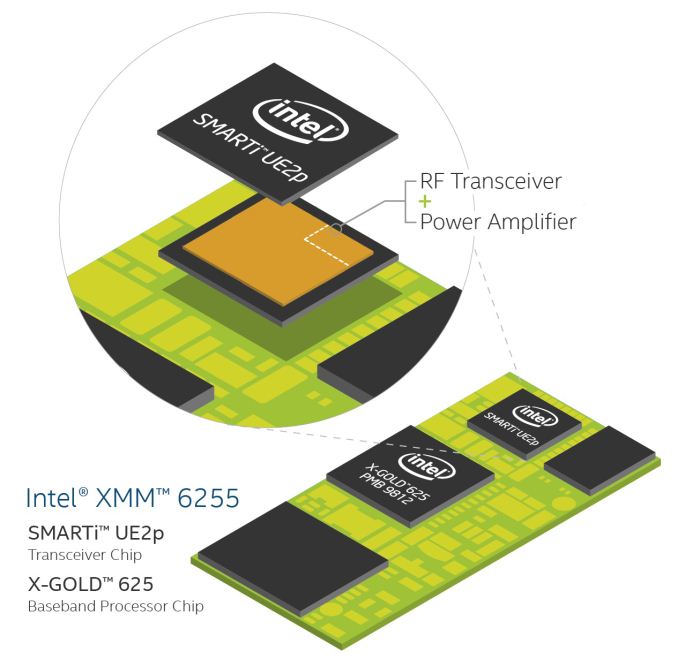Intel Announces XMM6255: The World's Smallest Standalone 3G Modem
by Brandon Chester on August 26, 2014 12:44 PM EST- Posted in
- Wearables
- Intel
- Smartphones
- Mobile
- XMM6255

Today Intel announced their XMM6255 modem which is aimed at providing 3G network connectivity to the many future connected devices that will make up the Internet of Things (IoT). At approximately 300mm^2 in size, Intel is claiming that XMM6255 is the world's smallest standalone 3G modem. Their hope is that its small size will allow it to be integrated into small internet connected devices such as wearables, small appliances, and security devices.
XMM6255 uses Intel's X-GOLD 625 baseband and its SMARTI UE2p transceiver which is the first transceiver that integrates the transmit and receive functionality and the 3G power amplifier on a single die with its own power management. Intel claims this protects the modem from damage caused by excessive heat, voltage spikes, or overcurrent, which makes it a good choice for IoT applications like safety monitors and sensors where a hardware failure could present a safety risk. Integrating the power amplifier and transceiver on a single chip also reduces the bill of materials and power consumption, which allows XMM6255 to be put in low-cost and low-power devices.
XMM6255 typically comes in a dual-band HSPA configuration with 7.2Mbps downstream and 5.76Mbps upstream speeds. Up to quad-band 2G support can be optionally added, but requires an external power amplifier that Intel is billing as low-cost. A-GPS is also supported but is again optional.
XMM6255 represents another move by Intel to becoming a big part of the IoT market. Intel expects that the IoT market will be made up of billions of devices in the coming years, and getting a head start is a good way to make sure that many of them have Intel inside.
Source: Intel










8 Comments
View All Comments
jeffkibuule - Tuesday, August 26, 2014 - link
Hopefully this means Arduino shields with 3G aren't so godly expensive. Charging $100 for a board with 3G is highway robbery.Dahak - Tuesday, August 26, 2014 - link
not to really nit pick, but it looks like the device is a dual chip solution and not a single chip. I thought most 3g modems now a days where all single chipextide - Tuesday, August 26, 2014 - link
No, they typically have an external Transceiver and RF Power amp.Morawka - Tuesday, August 26, 2014 - link
current 3g solutions are multiple IC solutions.Yes your right that the modem processor on Die in qualcomm's SoC's, but there are still separate chips for Transceiver and external power amplifier chip. So this goes down to 2 IC's vs the competition which has 3 or more.
Morawka - Tuesday, August 26, 2014 - link
this whole intel package has about the same volume as a USA Currency 1 Cent Pennyextide - Tuesday, August 26, 2014 - link
What I find interesting is that they tout it's small size and the on-die power amp, but then to get quad band support you have to use an external power amp? That seems pretty lame!toyotabedzrock - Tuesday, August 26, 2014 - link
Looks like a 4chip package to me. And Intel will not be willing to sell for cheap. Plus cell companies will make the market for this very limited because they will want high subscription fees.Morawka - Wednesday, August 27, 2014 - link
i've got a Tagg pet tracker that has a 3G modem inside with GPS, the whole package is $7 a month, so it's not to terribly expensive. It's totally independent from my personal cell phone plan.These IoT devices usually use very little data, be need a constant 3g connection. This is pretty cheap to offer because of MVNO carriers who buy data/minutes in bulk.